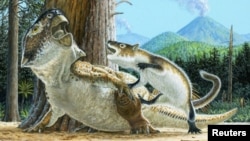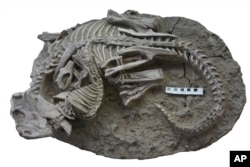A new fossil study by researchers from China and Canada suggests that ancient mammals may have attacked and eaten larger dinosaurs.
The scientists looked at a fossil found by a Chinese farmer in 2012. A fossil is the mineralized remains of an animal or plant left in an ancient rock.
The scientists said the fossil is from 125 million years ago. They published their findings recently in the journal Scientific Reports.
The scientists believe a mammal, similar to a badger, attacked a small, beaked dinosaur. During the attack, the animals were caught up in a lava flow from a nearby volcano. The moment was locked in time until it was found over 12 years ago.
Researchers call the place where the fossil was found “China’s Pompeii.” Pompeii was a city in Italy that was caught in a volcanic eruption about 2000 years ago. Ash covered the city and preserved moments from daily life. Researchers discovered the ruins of the city about 500 years ago.
In the past, dinosaur researchers believed small, scavenging mammals might have eaten dead dinosaurs. However, they were not sure that mammals attacked living dinosaurs.
Jordan Mallon is a paleobiologist at the Canadian Museum of Nature in Ottawa, Ontario. He was one of the study’s writers.
“I’ve never seen a fossil like this before,” he said.
Steve Brusatte is a paleontologist at the University of Edinburgh in Scotland. He did not work on the study. He described the fossil as a “freeze frame” or something like a photograph.
“It turns the old story on its head,” he said. Brusatte said the old idea was that dinosaurs ruled the world with small mammals “in the shadows.”
Mallon said he would be happy for other scientists to examine the fossil if they are concerned that it might not be real.
He described the mammal as about the size of a house cat. He said the dinosaur was about the size of an average dog.
He said the species of dinosaur is Psittacosaurus and the mammal is called Repenomamus. The dinosaur ate plants, but other dinosaurs ate meat and hunted mammals.
Mallon said it would have been more common for a dinosaur to hunt a mammal, but the fossil he studied shows something new.
“We now know that the mammals were able to fight back, at least at times,” he said.
I’m Dan Friedell.
Dan Friedell adapted this story for Learning English based on a report by the Associated Press.
____________________________________________________
Words in This Story
beaked –adj. having a beak like a bird which is made of hard material
lava –n. melted rock
eruption –n. the explosion that results when pressure underneath a volcano bursts out
scavenging –adj. something that does not hunt for live food but that looks for animals killed by other causes
paleobiologist –n. a scientist who studies prehistoric life
species –n. a kind of animal or plant that can reproduce with others of its kind
____________________________________________________
We want to hear from you. What do you think of the new information about ancient mammals?
Here is how our comment system works:
- Write your comment in the box.
- Under the box, you can see four images for social media accounts. They are for Disqus, Facebook, Twitter and Google.
- Click on one image and a box appears. Enter the login for your social media account. Or you may create one on the Disqus system. It is the blue circle with “D” on it. It is free.
Each time you return to comment on the Learning English site, you can use your account and see your comments and replies to them. Our comment policy is here.















Forum